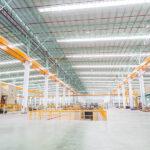Integrated Building Automation Systems (BAS) for Smarter Facility Management
Home » Solutions » Smart Controls » Building Automation System (BAS)
Building Automation Systems (BAS) give facility operators centralized control over HVAC, lighting, metering, and energy systems. By connecting these systems under one intelligent platform, buildings can run more efficiently, respond to real-time conditions, and reduce energy waste.
Table of Contents

What Is a Building Automation System (BAS)?
A Building Automation System (BAS) is an integrated platform that connects, monitors, and controls mechanical and electrical systems throughout a facility. It allows operations teams to automate schedules, track performance, respond to alarms, and make real-time adjustments that improve energy use and occupant comfort.
Modern BAS platforms connect:
-
HVAC systems (thermostats, dampers, rooftop units)
-
Lighting systems (zones, occupancy schedules)
-
Energy meters and submeters
-
Alarms and building status sensors
-
Ventilation and indoor air quality monitoring
-
Integration with BMS or IoT platforms
A properly implemented BAS offers better visibility, increased automation, and the ability to benchmark and improve building performance over time.
Why Implement a BAS?
Key Benefits:
-
Improve HVAC scheduling and reduce wasted runtime
-
Centralize building control in one easy-to-use platform
-
Gain real-time visibility into system performance
-
Detect and address maintenance issues earlier
-
Automate lighting schedules and equipment shutdown
-
Reduce energy use and improve operational efficiency
-
Track building data for benchmarking and compliance
-
Enhance occupant comfort with zone-level adjustments
How BAS Works
A BAS uses a network of sensors, controllers, and user interfaces to automate and optimize building operations. Here’s how it functions:
-
Sensors track temperature, humidity, occupancy, lighting, and air quality
-
Controllers execute automated actions based on pre-set rules or real-time input
-
Software interface allows users to monitor systems and adjust settings remotely
-
Schedules and alerts manage lighting, heating/cooling, and ventilation in sync with facility use
-
Dashboards provide insights on performance, comfort zones, and energy use
BAS platforms often integrate with BMS (Building Management Systems) and EMS (Energy Management Systems) for more advanced control and analysis.
How BAS Reduces Energy Waste
BAS reduces energy consumption by ensuring building systems operate only when needed and at optimal performance:
-
HVAC and lighting automatically shut down in unoccupied zones
-
Equipment runs more efficiently and predictably
-
Real-time feedback leads to faster resolution of inefficiencies
-
Energy use can be tracked and compared across time, zones, or facilities
-
Peak load management and demand response integration can reduce utility costs
Facilities That Benefit from BAS
Related Facilities
Schools, hospitals, municipal buildings, corporate offices, and large commercial or industrial facilities—particularly those with aging infrastructure, large HVAC loads, or sustainability mandates.
Our BAS Implementation Process
-
Facility Evaluation – Review existing mechanical systems, controls, and user needs
-
System Design – Define control points, schedules, zones, and dashboards
-
Product Selection – Choose BAS components, sensors, and integration protocols
-
Installation – Install or upgrade system components and software interfaces
-
Commissioning & Training – Ensure functionality, then train staff on use
-
Ongoing Support – Offer maintenance, optimization, or remote monitoring if desired
Incentives and Funding for BAS Projects
Many utility and state programs offer incentives for controls and automation projects, especially those that:
-
Reduce peak demand
-
Lower total building energy use
-
Qualify for decarbonization or electrification incentives
-
Support smart building and ESG goals
We help identify funding sources and can integrate BAS into broader energy upgrade packages.
Take Control of Your Building’s Performance
Whether you’re retrofitting a legacy facility or building smart from the ground up, a BAS can help you reduce energy waste, improve comfort, and make data-driven decisions. Let’s design the right system for your building.








